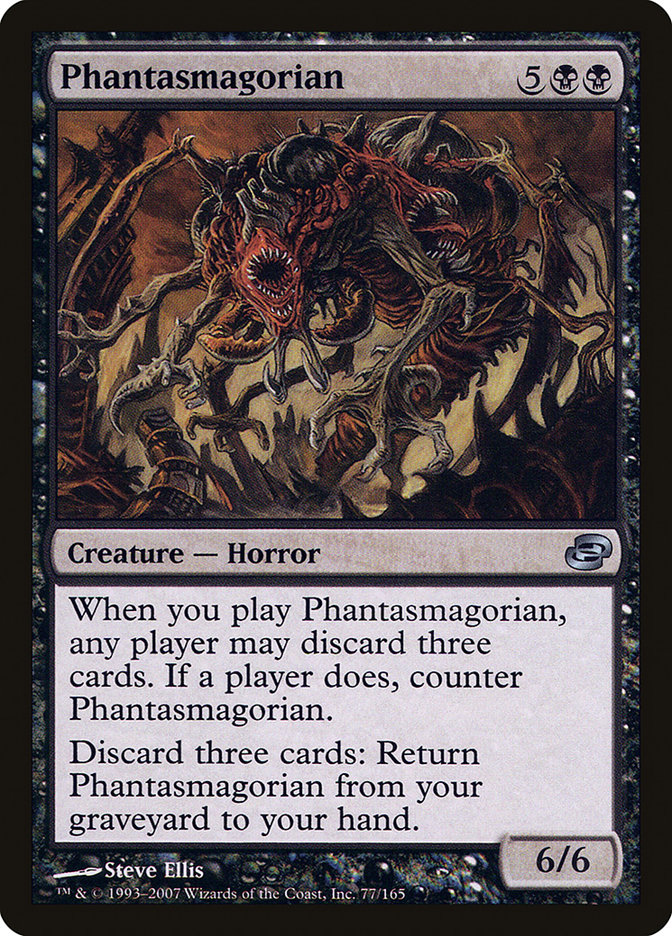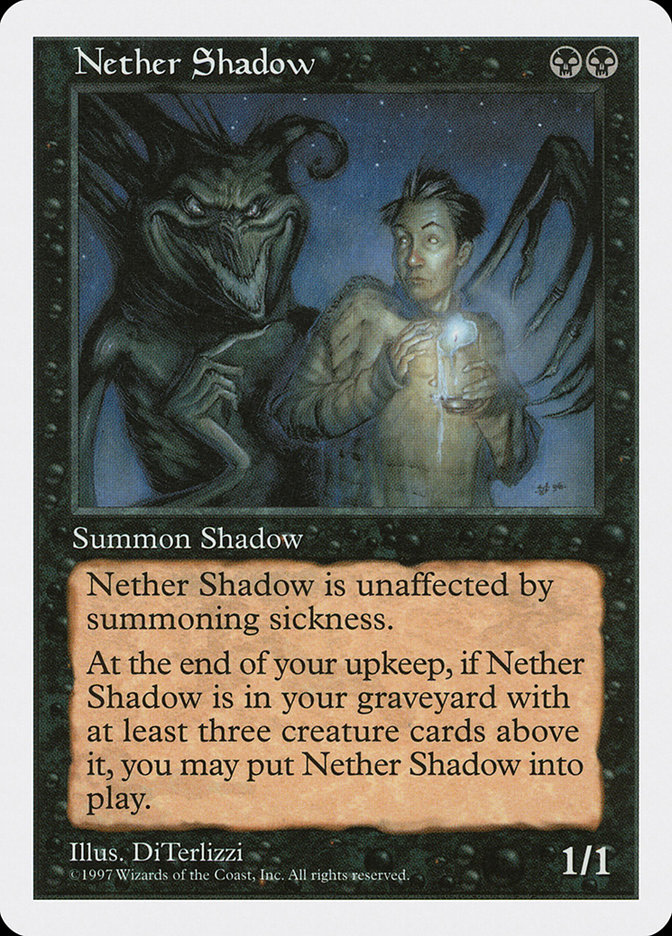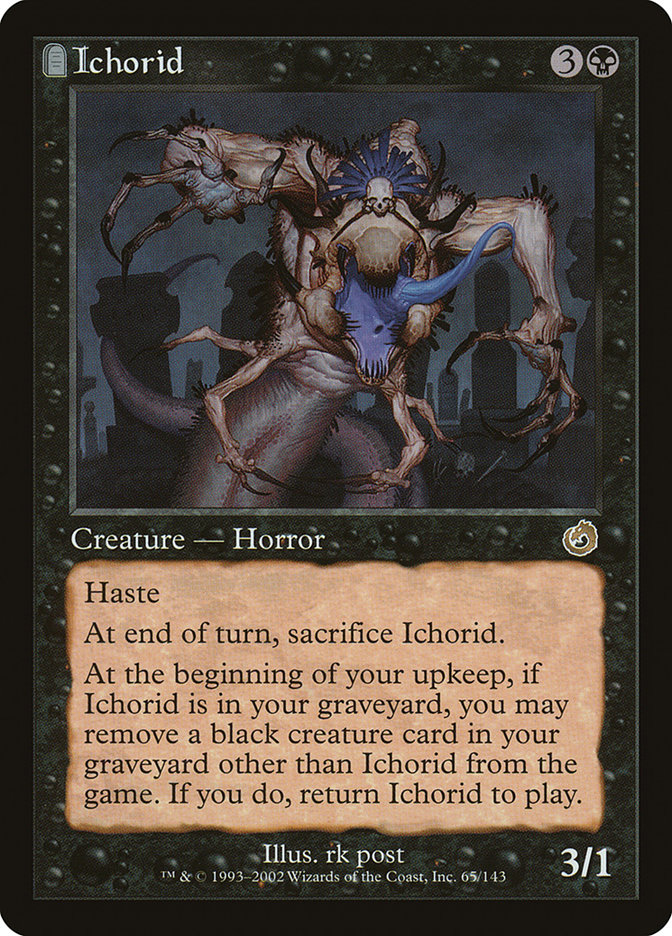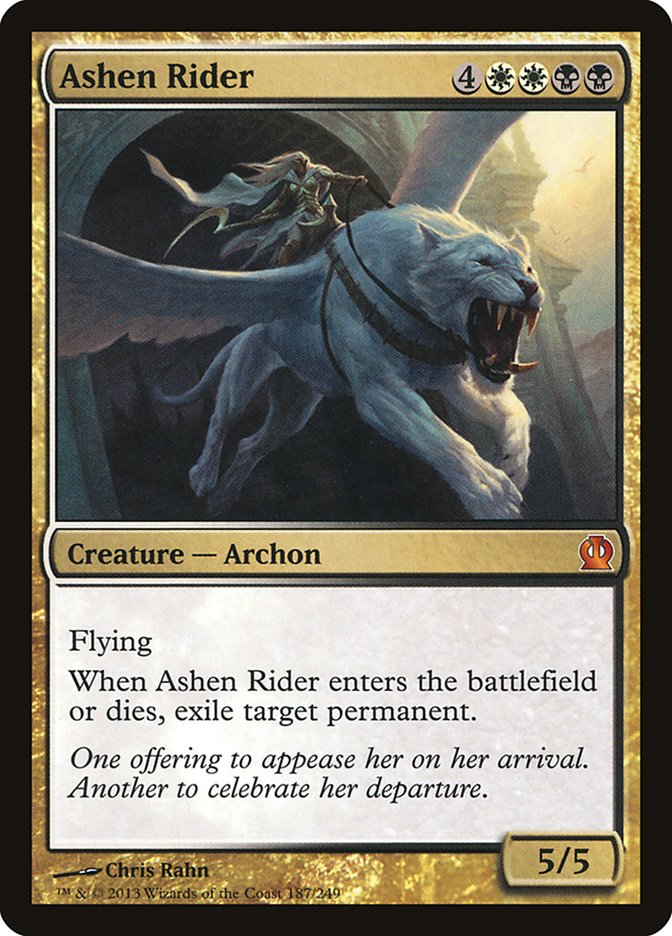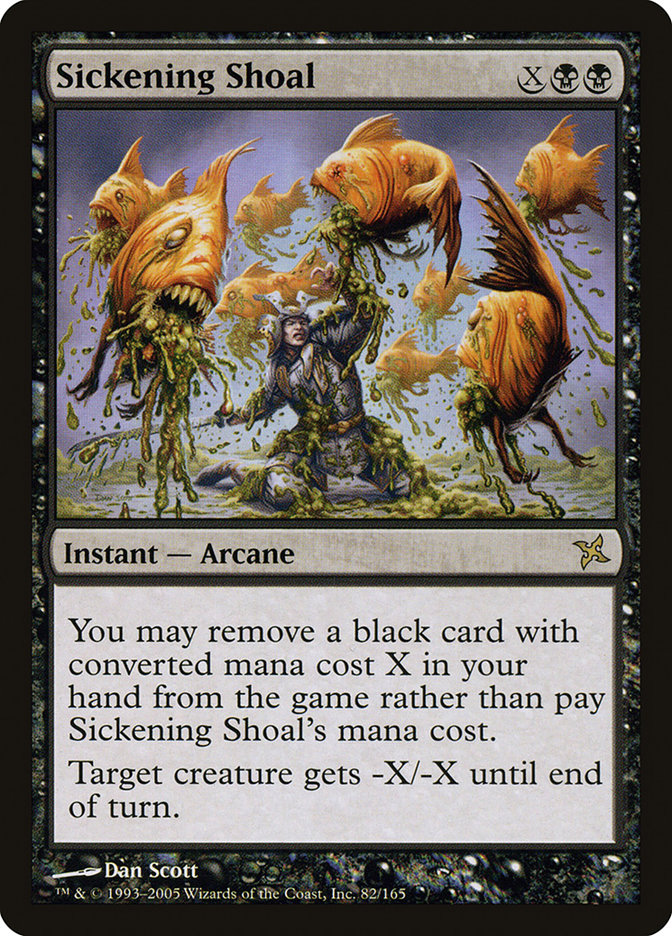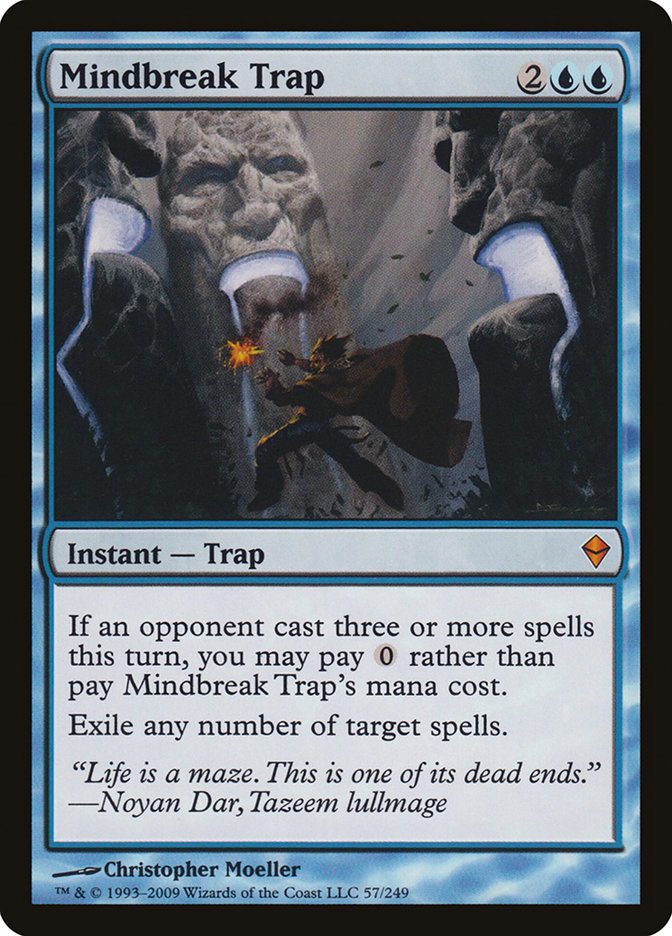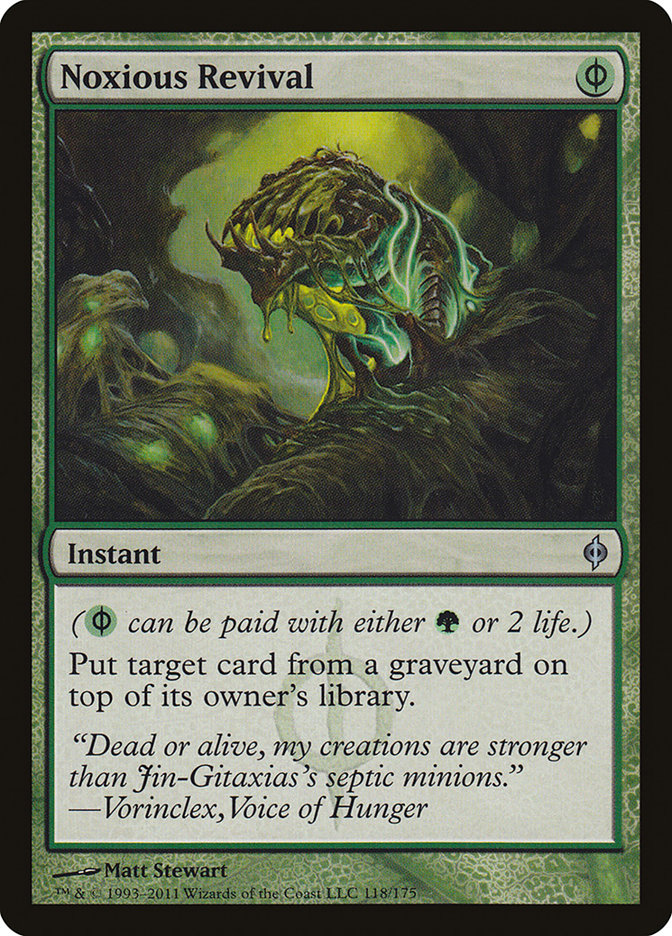Hello fellow graveyard enthusiasts! My name is Michael Boland. I’m a PTQ grinder from Santa Cruz, and I’ve been playing competitive Magic for about six years with a few decent finishes, including an appearance at Pro Tour Return to Ravnica, a Super Sunday Series Championship qualification at Grand Prix Sacramento, and a Top 64 at Grand Prix Las Vegas. I’m here to tell you about the deck I piloted to the Top 8 of the latest StarCityGames.com Legacy Open in Los Angeles playing fewer lands than anyone else in the tournament: Manaless Dredge.
Playing Without Lands
I first encountered this deck when Mental Misstep was still legal, losing horribly with Esper Stoneblade while holding a grip of dead counterspells and reading all the weirdo cards my opponent played. Even though blanking Misstep is no longer a concern, there are still so many Wasteland, Daze, and Force of Will out there that the manaless approach remains viable. Here’s the list I played in the Open:
Creatures (42)
Spells (18)
Sideboard

If you haven’t seen this deck before, it will look pretty strange. It doesn’t play lands and spells like a normal Magic deck—instead, it chooses to draw first, immediately discards an eighth card to the cleanup step, and proceeds to move cards from the library to the graveyard as quickly as possible using the dredge mechanic to replace its draws.
Once you’ve generated some free creatures courtesy of Narcomoeba, Ichorid, Nether Shadow, and Bridge From Below, you Flashback Cabal Therapy to strip the opponent’s hand of answers and then sacrifice three creatures to Dread Return a Balustrade Spy. You target yourself with the ability, milling your entire library (since there are no lands in it), and proceed to Dread Return a Flayer of the Hatebound and then a Golgari Grave-Troll to shoot the opponent in the face for somewhere around 40 damage.
The phases of the turn sort of serve as your spells, and free cantrips from Street Wraith and Gitaxian Probe generate more dredging and speed up the whole process. Playing this deck is unlike playing any other deck in Magic; you’re playing a fundamentally different game than the opponent, so they usually just sit there doing random irrelevant stuff while you grind them down with free abilities and inexorable Zombies. You’re not so much piloting a deck as herding a horde of mad monsters toward your opponent—just let your cards loose and they’ll do the work for you. All you have to do is hit your triggers and figure out what to name with Cabal Therapy.
The most important and often overlooked card in the deck is Phantasmagorian. This unplayable creature from Planar Chaos is the best possible discard on turn 1, allowing you to dump your whole hand to its last ability and kick start the dredging process. You can discard either three or six cards to it (in the opponent’s end step before you dredge for the first time on turn 2) by activating its last ability twice; you discard three, hold priority, and discard anther three with it still in the graveyard.
This is a common line of play that leaves you with only Phantasmagorian and one other card in hand, ideally a Gitaxian Probe to cast and try to win the game on the second turn. Discarding Phantasmagorian rather than a card with actual dredge also allows you to play around Deathrite Shaman sniping your single creature out of the graveyard on turn 2 (as can cycling Street Wraith in response to Deathrite’s ability if you don’t have a Phantasmagorian handy). Later in the game, you can often get two copies Phantasmagorian going to ensure you always have a Golgari Grave-Troll in the bin for maximum dredging.
You can do a fancier trick with Phantasmagorian too if you have a Street Wraith and another cantrip you want to keep in hand. Say you have Phantasmagorian in your bin, Gitaxian Probe, Street Wraith, Golgari Grave-Troll, and four other cards in your hand on the opponent’s end step before your second turn. The play here is to discard Troll and two other cards, hold priority with Phantasmagorian in the grave, cycle Street Wraith dredging Troll back to your hand, and then discard the Troll and two other cards to activate Phantasmagorian again.
This leaves you with Phantasmagorian and Probe in hand and Troll in the bin ready to be dredged in the draw step! The sheer amount of cards you can dredge with this opening makes for a very powerful start, and every time this play came up during the Open, I won on the next turn.
One general tip to keep in mind when dredging is to put Nether Shadow as low as possible in your graveyard. Although you cannot change the order of cards already in your graveyard in Legacy (thanks to the existence of cards like Nether Shadow), whenever you dredge a group of cards, you can choose the order they get put into the bin. This means whenever you’re dredging or using Balustrade Spy, make sure to sort the Nethers to the bottom of however many new cards you’re putting into the grave to maximize the chances of having three creatures above them.
Figuring out whether to use Ichorid and which creatures to exile is one of the few times playing this deck is more art than science (the other main one being Cabal Therapy). In general, I err on the side of always reanimating Ichorid since if you dredge into a Bridge from Below during the draw step, the upside of getting a Zombie token when Ichorid dies is very high. Street Wraith is the primary food for Ichorid since it doesn’t do anything once it’s in the bin. Any copies of Balustrade Spy after the first one are fairly useless too, as are Shambling Shell and Golgari Thug once you have a few better dredgers in the grave, so those are the next tasty morsels you should go after with Ichorid.
Get hasty 3/1 beats in wherever you can (and remember Nether Shadow has haste too), but usually try not to attack into any board where the opponent can trade or chump with a creature and exile your Bridges. Also remember that Bridge exiles off of any creature dying on the opposing side even though it only makes Zombies from your nontoken creatures dying. Bridge From Below has my vote for most confusing card played in Legacy, so read it, learn its secrets, and know it inside and out before taking Dredge to a tournament.
When casting Cabal Therapy, remember that all you have to do upon casting it is sacrifice a creature and declare a target player; you don’t name a card until it resolves. Also remember to trigger Bridge Zombies before your Therapy or Dread Return resolves since otherwise you can be considered to have missed them. I never Therapyed myself during the tournament, but that play sometimes comes up if you need to get a dredger or Balustrade Spy into the yard, so remember that is an available play as well.
Card Choices
I first played this deck with four copies of Chancellor of the Annex maindeck after seeing a list by Gerry Thompson. While the Chancellors were sometimes good against Deathrite Shaman or combo decks like Belcher, I found them cluttering up my draws more than their usefulness warranted—they don’t draw cards, don’t dredge, and aren’t the correct color for Ichorid. I ended up replacing them with two copies of Mishra’s Bauble and two additional dredgers (the fourth Shambling Shell and the singleton Greater Mossdog), and I love this configuration. We’re really scraping the bottom of the barrel with dredgers when we’re to the point of playing Mossdog since it’s not even black, but it’s better than Darkblast simply because it’s a creature for Nether Shadow.
It’s possible that Urza’s Bauble is better than Mishra’s. Both cards provide some very marginal value before cantripping, and looking at a card in their hand can be good with Cabal Therapy. But right now I prefer siding with Mishra to look at their top card. This gives you information the opponent doesn’t even have, which can inform your Cabal Therapy or Noxious Revival and just generally let you outplay the opponent.
In my match against Belcher in round 2 of the Open, for example, I was able to Gitaxian Probe his hand and Bauble his top card after he passed with a Charbelcher in play and two cards in hand (Tinder Wall and Elvish Spirit Guide). He clearly needed to rip a mana source to activate Belcher (in which case I could weaken his hand by Therapying the Spirit Guide) or an LED (nothing I could do if that was his top card). Knowing his top card was just an Empty the Warrens thanks to the Bauble allowed me to forgo casting Therapy, preserving a creature in play and guaranteeing a Dread Return kill the next turn.
Some other cards I considered include numerous different Leylines, Basking Rootwalla, Memnite, Contagion, more Baubles, and Gigapede. Leylines seem sweet at first and can be very powerful, but they essentially Time Walk you since their card disadvantage delays your cleanup discard by a turn. Free creatures enable more explosive openings with Dread Return, and more Baubles facilitate faster dredging. But cutting graveyard-based cards to make room for cards that only function from the opening hand is dangerous. Bricking an entire dredge, particularly the first one on turn 2, will cost you at least a turn off your clock.
Dredging an abysmal double Gitaxian Probe, Balustrade Spy, Street Wraith off of a turn 1 Golgari Thug was the closest I came to losing a game 1 all day in an off-camera feature match against U/W/R Delver, but luckily for me my opponent made some mistakes to keep me in it. You want cards that make for explosive openers (Probe, Wraith, Bauble) while also maintaining a critical mass of graveyard interaction, so finding the correct mix is tough. For now I like sticking with four copies of Gitaxian Probe and Street Wraith along with two copies of Mishra’s Bauble since it feels like a fairly perfect configuration.
Tournament Report
I had planned on playing a traditional Dredge deck at Sunday’s Open, but I ended up being unable to track down four copies of Lion’s Eye Diamond, so Manaless it was. The way my rounds played out, I actually think Manaless Dredge ended up being way better since RUG Delver just rolls over to it rather than having actual lands to target with Wasteland and spells to counter. Even with Faithless Looting and Lion’s Eye Diamond allowing you to turbo dredge your library, traditional Dredge is actually only marginally faster than Manaless in my experience; it doesn’t look like this pile of wacky triggers and weirdo activated abilities should win on turn 2 or 3 very often, but it definitely does.
My actual matches during the Open were mostly standard Dredge games—my opponent lacked relevant interaction while I just sat there milling myself and eventually won in a flurry of Cabal Therapy and Zombie tokens. I think I won about two-thirds of my games resolving Dread Return and the other third just from value beats/chumps with Nether Shadow and Narcomoeba while farming Bridge From Below tokens every turn. Combat can be very unintuitive with this deck since you actively want to chump block rather than eat or trade with your opponent’s creatures in order to preserve Bridge from Below (also note that you can make Zombies before exiling Bridges if you do trade in combat since you control the order in which the Bridge triggers go on the stack).
My opponents often had to kill their own creatures in order to exile my Bridges, which is usually just fine since it slows their clock so much. One particularly awkward moment came when my RUG opponent tried to Lightning Bolt his own Nimble Mongoose. Sorry bro, none of this hexproof nonsense—the Goose has straight-up shroud!
I lost a few game 2s to my opponent successfully finding a Rest in Peace, Tormod’s Crypt, or Grafdigger’s Cage, but none of them were able to do that in both sideboarded games. RUG Delver in particular usually has only a single Cage and a single Crypt to work with, so they have to get fairly lucky to find one in both sideboarded games to take the match.
The sweetest match I played was against Reanimator. My opponent mulliganed a lot every game, but Pithing Needle on Phantasmagorian backed with counterspells and Thoughtseize slowed me down a lot. We ended up in a spot during game 2 where he Show and Telled a Griselbrand into play at eleven life while facing down my board of an 8/8 Golgari Grave-Troll, Ichorid, two Zombie tokens, a Narcomoeba, and two copies of Nether Shadow. I was without any great options, so I had to put him to three life (hitting with everything into his block of Griselbrand on Ichorid).
This left my opponent hellbent but with a turn to attack me with Griselbrand and hope to draw into the win before dying to my next attack. He hit me, activated Griselbrand to go down to three life, and was able to assemble another Show and Tell, this time for Elesh Norn, Grand Cenobite. While that took care of all my non Golgari-Grave Troll creatures, I had another in my hand for my side of Show and Tell, this one a 10/10 that threatened to attack him to death through his one untapped Elesh Norn. He tanked for a while but eventually emerged with a Reanimate on my Narcomoeba, taking him down to just one! Curse you, traitorous jellyfish and your CMC of just two!
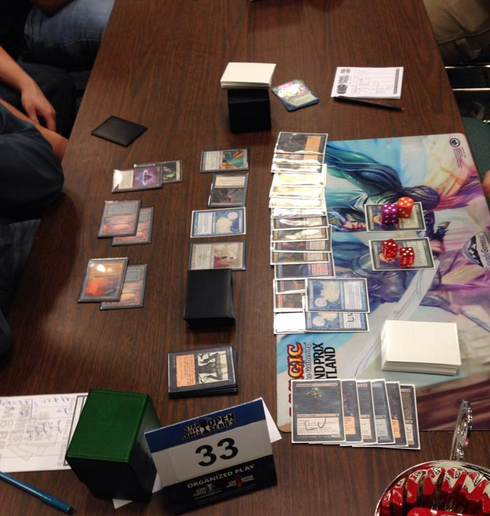
Some other interesting moments from the tournament:
- A U/W/R opponent reading Bridge From Below intently many times and then coming up with “okay, Narcomoeba trigger on the stack in your draw step, Lightning Bolt your Ichorid.” “Sure? I get a Zombie.” “Oh, oops.”
- That same opponent being unable to cast Rest in Peace for three turns thanks to two copies of Wasteland as his only lands. He drew Tundra the turn after I assembled an Ichorid + Cabal Therapy (and you can’t Daze a Therapy off only Wasteland). Mise!
- A different U/W/R opponent ripping Rest in Peace on turn 4 right after I’d made about fourteen Zombie tokens. He revealed it, sighed, and scooped.
- Bricking on any Bridge from Below, Narcomoeba, or Ichorid for three turns (to punish my Jund opponent for using his Deathrite Shaman exclusively for mana) leading to my only match loss in the Swiss.
- The wide-eyed terror on my opponents’ faces every time I won the die roll and chose to draw.
- About 80% of my game 2s in which my opponents still chose to play first. Mise again!
- The game versus U/W/R that I won with Greater Mossdog as my only dredger for the first three turns of the game. Turn down for what!
- Mindbreak Trapping a Belcher player down to no cards in hand or on the battlefield.
- Getting demolished in the quarterfinals in an unwinnable Top 8 matchup. Shout outs to Bojuka Bog, Crop Rotation, Vesuva, Rest in Peace, and the valiant Narcomoeba, who stood solo versus the world for a turn before getting Ulamog, the Infinite Gyred.
An alternate version of this deck I’ve seen recently gives up the Balustrade Spy kill in favor of reanimating Whirlpool Warrior and Whirlpool Rider, giving you just enough blue cards to run Force of Will and Disrupting Shoal. This gives you outs to cards like Rest in Peace, but personally I prefer the more stable and faster kill of my Balustrade Spy version. The Rest in Peace decks often have copies of Daze or Force of their own to back up their hate cards, and Spy has utility as a black creature for Ichorid to eat. Being able to kill with Flayer of the Hatebound outside of combat with the Spy build is also useful, giving you outs to cards like Ensnaring Bridge and Elephant Grass. If they’re playing Rest in Peace, I think the best sideboard strategy is still +4 Hope // Pray, +4 YOLO.
It’s also worth noting how (similar to Leylines) having to cast turn 1 Force of Will on something like a Grafdigger’s Cage puts you so far down on cards that you’ll have to pass multiple turns before being able to discard in Cleanup. Is a one-mana Grafdigger’s Time Stretch so much more beatable than a one-mana Grafdigger’s Win The Game that it’s worth diluting your graveyard synergies to play Force of Will? I really don’t think so.
That being said, if Rest in Peace is your primary Force of Will target, the card disadvantage is less of a problem since you’ve at least had a chance to discard once before they cast it. In general, though, if you expect to face lots of Rest on Peace and other hate, I would say just play a different deck rather than try to adjust Manaless Dredge to beat that field.
Mulliganing
Don’t do it. I took zero mulligans over the course of the nine-round Open, which I doubt any other (non-Dredge) player can say. Of course things get dicey if you don’t have a dredger in your opener, but with seventeen in the deck it’s very unlikely (and didn’t happen to me all day). Even if you’re missing dredgers, I think it’s usually correct to keep, knock the deck, and trust in your first draw step plus Gitaxian Probe and Street Wraith to miracle the missing piece. Every mulligan literally sets you back a turn, so once you pick up this deck you lock yourself in to keeping basically any seven-card hand. We’re not here to play Magic with our friends—we’re here to keep seven, move cards from pile A to pile B, and unleash Zombies on fools.
Sideboarding
The pool of cards that function in a deck without lands is fairly tiny, so trying to scrape together fifteen more after you’ve already built a 60-card deck is pretty rough. I built a sideboard that is basically just answer cards for other fast combo decks, a package for Show and Tell, and wild card Sickening Shoal that I bring in against anything with creatures. It’s not pretty, but with a maindeck this perfect, who needs to sideboard?
Ashen Rider is fairly self-explanatory; it’s just the best answer to Show and Tell that’s also black and a sick reanimation target on its own. You can go fairly deep Dread Returning and Cabal Therapying the Rider between the graveyard and battlefield to bust up lots of permanents. Serra Avatar looks a bit weirder since you obviously can’t reanimate it, but it is another piece of the Show and Tell package. Having it in your deck allows you to Show and Tell a Balustrade Spy on their turn; mill yourself down to just Avatar; untap; and win if they pass the turn with their Emrakul, the Aeons Torn or Griselbrand or whatever.
If you draw Serra Avatar itself, you can also just put it into play from Show and Tell, which usually forces the opponent to chump away whatever they’ve put into play (unlike something like Progenitus or Blightsteel Colossus that won’t kill an Emrakul in combat). So by adding one Serra Avatar, you effectively unlock four copies of Balustrade Spy as additional powerful Show and Tell targets. It’s also worth noting that Golgari Grave-Troll can be an enormous Show and Tell target and is often naturally in your hand from being dredged.
Sickening Shoal is the card I boarded in the most, usually just as a straight swap for Mishra’s Bauble or Greater Mossdog against all the non-combo decks like Jund and Delver. Again, it only functions in the opening hand, so you don’t want too many of them, but it can be clutch in the right situation as an answer to Deathrite Shaman or a creature equipped by Umezawa’s Jitte (both of which came up during the Open). It also gives you a desperation out if you’re locked under an Elesh Norn, Grand Cenobite and forced to actually draw cards looking for an answer—luckily Phantasmagorian has a CMC of seven, perfect for Shoaling Elesh Norn or Griselbrand. It’s possible a second one could find its way in the deck.
Mindbreak Trap and Surgical Extraction are the most powerful sideboard cards, giving you interaction in the early game against things like Storm, Tin Fins, and Belcher. Noxious Revival usually acts as a fifth Surgical versus Reanimator type decks, but you can get fancy by recycling Narcomoeba back on your deck or fizzling opposing Surgicals. I’ve also been playing with the idea of running lots more Noxious Revival as a disruptive element against decks like U/W/R Delver, whose game plan is to spend the early turns cantripping in search of hate cards—stacking a fetch land back on their deck will often slow them down a turn, which can make all the difference.
Another scenario that sometimes comes up is Cabal Therapying the opponent, only to have them Brainstorm their hate cards to the top of their deck in response. At this point, Noxious on a fetch land or whatever useless card you Therapy from their hand can put them a turn further away from casting whatever they’ve hidden on top. Fringe cases for sure, but you gotta look at all the angles when you’re trying to win with no mana.
Going Forward
If U/W/R Delver overtakes RUG Delver as the premier Delver deck in the metagame (as it seems to be doing), Manaless Dredge will be less well positioned. Aside from that, though, it would take a pretty serious uptick in the amount of graveyard hate in people’s Legacy decklists to make Manaless Dredge a bad choice. If the metagame moves toward more aggressive combo decks like Tin Fins, Storm, and Belcher, I like Manaless Dredge thanks to all the free disruption you can play after board. I didn’t get to play against Sneak and Show at all in the Open, but that is another popular deck that leaves itself pretty open to getting Dredged.
If you’re looking for a sick Legacy deck that breaks all the rules and preys on unprepared opponents, give Manaless Dredge a try! You should goldfish it as many times as possible before playing it in a tournament since forgetting an upkeep trigger or Bridge from Below token is the easiest way to lose.


